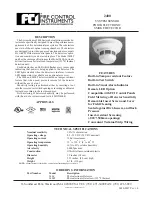
Wiring Connections
The following sections detail connections for each wire, of
each system’s wiring harnesses. Always insure that the
Black ground wire is grounded, and that the secondary
wiring harness is plugged in, before connecting power
circuits to the control module. The best installation proce-
dure is to make all connections, and only then plug the
individual wiring harnesses into the system control module.
- NOTE -
Page - 6
Main Wiring Harness
(5-Wire Connector)
Red Wire - (Constant Power Input):
The Red wire's function is to
supply Constant Positive 12 Volts for security system's operation. When 12 Volts
is first applied to the Red wire, the system will revert to the state in which it was in
when power was taken away. If the vehicle is to be serviced, especially if it involves
the battery, the system should be placed in Valet Mode. This will prevent the system
from being activated if the battery is disconnected and reconnected. The Red wire
also supplies 12 Volt Positive to the module's internal relay for flashing the parking
lights.
CONNECTION:
Connect the Red wire to a Constant Positive 12 Volt source.
This source should have Positive 12 Volts with at least a 15 Amp capacity at all times
and in all ignition key positions. Connection locations can be at the supply wire at
Black Wire - (Ground):
The Black wire provides Negative ground for the
system; proper connection of this wire is very important.
CONNECTION:
Using the correctly sized crimp-on ring terminal, connect the
Black wire to the metal frame of the vehicle, preferably using an existing machine-
threaded fastener. Make sure that the ring terminal attached to the Black wire has
contact with bright, clean metal. If necessary, scrape any paint, rust or grease away
from the connection point until the metal is bright and clean. If the control module
has an insufficient ground connection, the security system can find partial ground
through the wires that are connected to other circuits, and function, but not
correctly. As the system can partially operate, a bad ground wire connection would
not likely be suspected, and in many cases a poor ground is difficult to diagnose.
pressing the “arm/lock” or “disarm/unlock” button. Only the output itself
will stop- pressing either button again will normally operate the system, and at
any time after the 28 second lock output period ends.
If either of the programmable outputs are set for lock or unlock operation (the next
two Programmable Features), the settings if this feature will operate the program-
mable outputs accordingly, in addition to the system’s primary DLS port doorlocking
outputs.
Feature #24 Horn Honk Output Functions
Factory Default Setting
Horn Honk Output
(
press
“disarm/unlock” button to program
)
Options:
OEM Alarm Disarm Output (
press
“arm/lock” button to program
)
Channel 5 Latch Output
(
press
“
II
” button to program
)
Channel 5 On Demand Output (
press
“
III
” button to program
)
The default setting of this feature is to operate the vehicle’s existing horn; either in
conjunction with the electronic siren, or in place of the siren. Using both the siren
and the horn creates an extremely effective security system, and be configured in
many vehicles without further parts. The remaining options are OEM alarm disarm,
and Channel 5, with the same operation parameters as described above for Channel
4, except that the “disarm/unlock” and “
III”
buttons operate it, and Feature #21 can
also change this channel’s button assignment.
Feature #23 (-) Parking Light Output Functions
Factory Default Setting
Parking Light Flash Output
(
press
“disarm/unlock” button to program
)
Options:
OEM Alarm Arm Output
(
press
“arm/lock” button to program
)
Channel 4 Latch Output
(
press
“
II
” button to program
)
Channel 4 On Demand Output (
press
“
III
” button to program
)
The default setting of this feature is to provide a negative flashing light output.
Options for this output are a (-) OEM alarm arm output, which is more frequently
encountered in newer vehicles. Other options are an additional remote output,
operated by the transmitter’s “arm/lock” and “
II”
buttons together, and in two forms
of operation: “Latch”, in which the output toggles (i.e.- turns on and turns off) with
each buttons press, and “On Demand” which is output occurring while the buttons
are being pressed. Feature #21 can change this channel’s button assignment.
Page - 31
CAUTION! Do not exceed the output capacities of either wire-
both outputs are rated at (-) Negative 250mA.




































